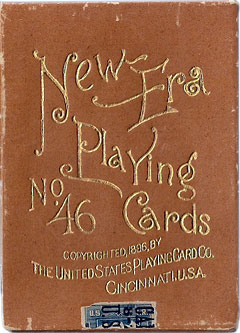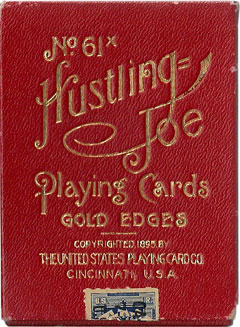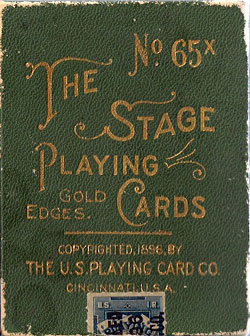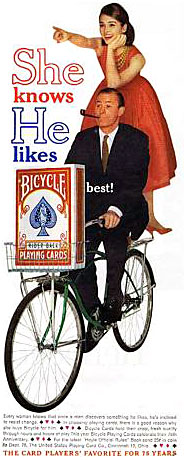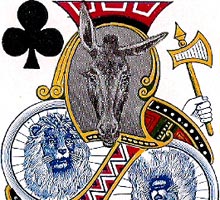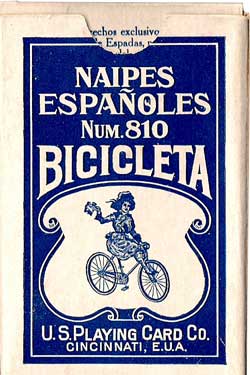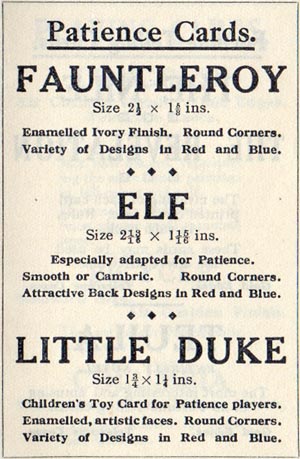The United States Playing Card Company
Over the years the pressures of competition and other market forces have led to many smaller manufacturers being taken over by larger ones. The outcome is that the U.S.P.C.C. is now the largest manufacturer in the United States.
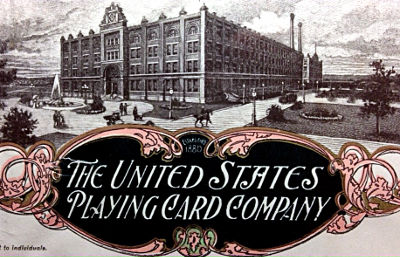 Tigers No.101
Tigers No.101Army No.303
Navy No.303
Army & Navy No.303
Steamboat No.999
Bicycle No.808
Bicicleta No.810
Tourists No.155
Congress No.606
Cabinet No.707
Capitol No.188
American Skat
No.4 Special Whist
Jumbo Bridge No.88
Squared Faro No.366
Monarch Bicycle
The Stage No.65
The Stage, 1908
Craddock Soap Theatrical
Trophy Whist No.39
New Era No.46
Circus No.47
Hustling Joe No.61
Ye Witches No.62
Los Leones No.71
Anheuser-Busch Spanish-American War deck
Norwood No.85
No. 500
Vanity Fair Transformation
Movie Souvenir
Cuba Souvenir
Panama Souvenir
Peru Souvenir
Historic Boston
Aristocrat
Sam the Olympic Eagle, 1984
McDonald’s
Star Wars Episode 1
Bicycle ‘Butterfly’
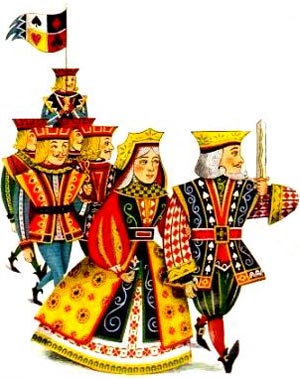
The United States Playing Card Co was established in 1894. Formerly it had been known as Russell, Morgan & Co (1881-1894). Over the years the pressures of competition and other market forces have led to many smaller manufacturers being taken over by U.S.P.C.C. These include: The Standard Playing Card Co. 1892-1895; Perfection Card Co. 1892-1895; New York Consolidated Card Co, 1892-1895; Andrew Dougherty 1907; Russell Playing Card Co. 1929; Heraclio Fournier, S.A. 1986; Arrco Playing Card Company 1987; and Hoyle Products 2001.
The outcome is that the U.S.P.C.C. is now the largest manufacturer in the United States, and has inherited many brands previously owned by smaller manufacturers.
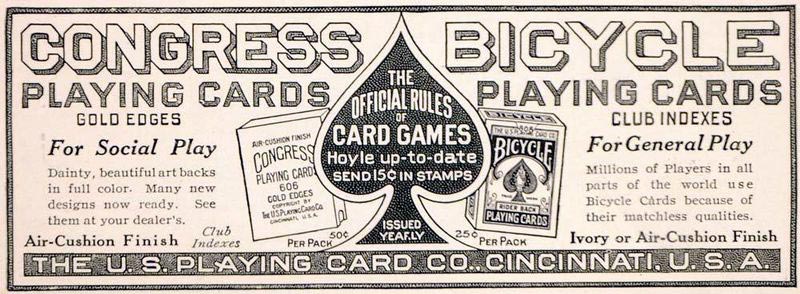
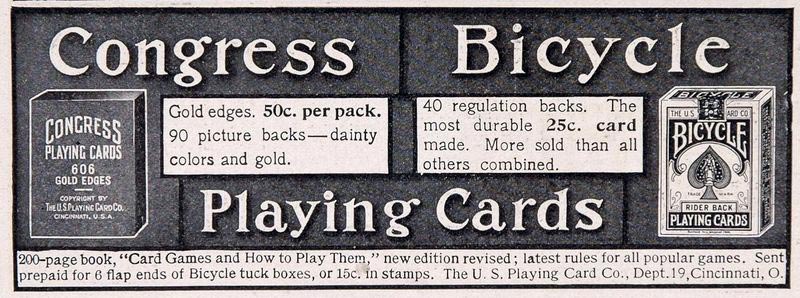
Question & Answer
QUESTION: When did the USPCC start putting a registered trademark symbol on the ace of spades in the Bicycle 808 Rider Back pack?
I have a pack which has a date code of "P", indicating 1991, and an advert extra card talking about “over 100 years of Bicycle cards”, and yet the ace of spades lacks the registered trademark symbol (as do the jokers). The lack of a registered trade mark would indicate a date of 1971, but that wouldn't tally with the bar code on the box and the "100 years" claim - Matt Probert.
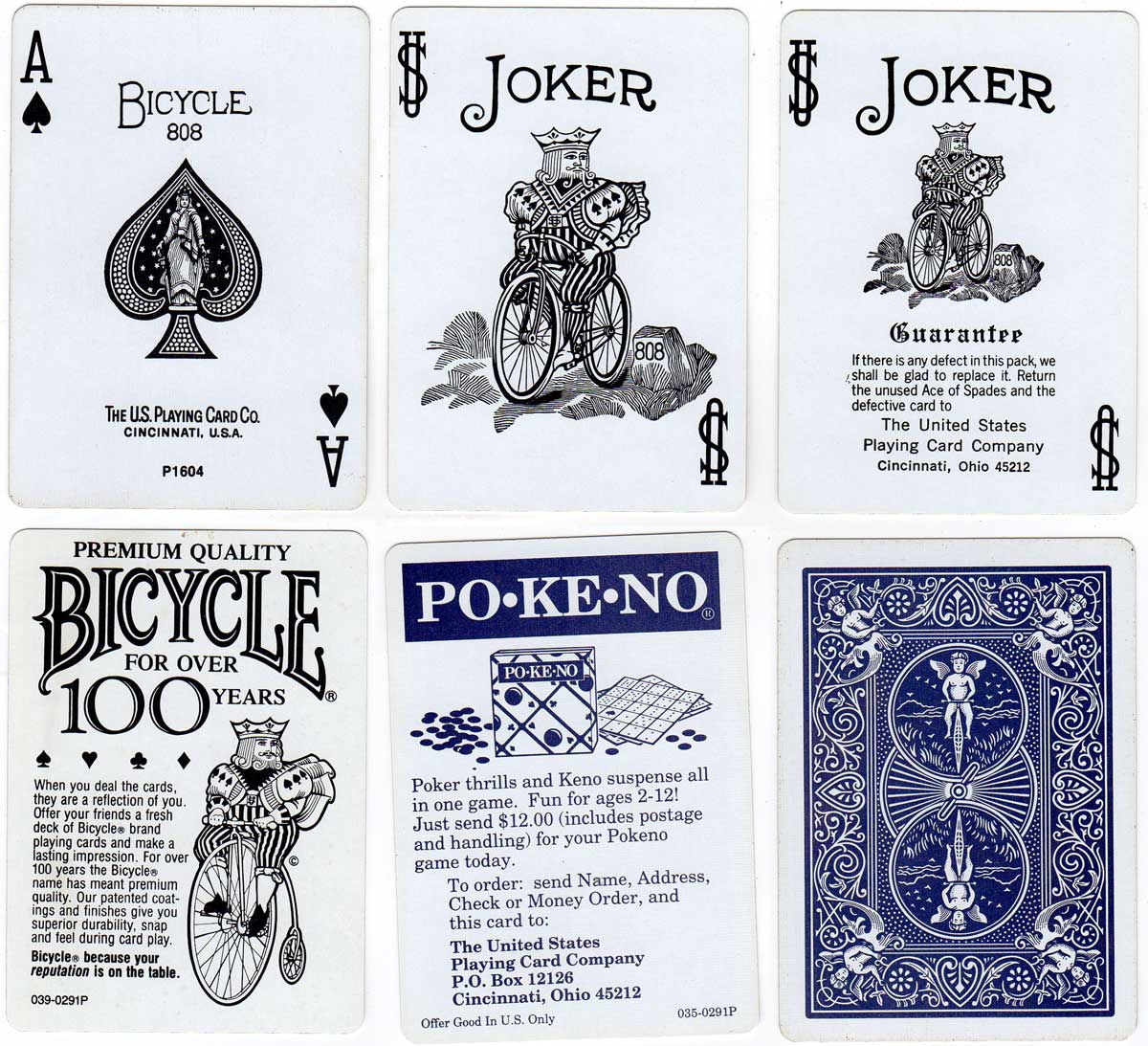
Above: Matt's pack of Bicycle 808 cards. See below "Discussion about date".
ANSWER: An interesting question. It will be necessary to keep a few facts in mind:
First, the trademark Ace of Spades was registered under No. 8,303 on May 31,1881 and, as you know, it has been and still is used for many of USPC’s other brands.
Second, the Bicycle brand was introduced in 1885 by the Russell & Morgan Printing Company.
Third, the Rider back was introduced in 1887 by the Russell & Morgan Printing Company.
Protection for the Rider back design is also covered under trademark law. Copyright protection is limited to a certain term. That term as been extended over the years but since the Rider design was introduced in 1887 copyright protection would have expired long ago.
Trademark rights, on the other hand, are valid and enforceable just as long as the trade mark is used. Holders of trademark rights are required to file an affidavit of use every year in the Office of Patents and Trade Marks in Washington, D.C. The principle is simple: ”Use it or loose it”. Obviously, the trademark Ace of Spades and the Rider back have been in continuous use for over 130 years, again satisfying the requirements for trademark protection.
The earliest Bicycle deck that I have is an 1888, US8 with a Wheel No.1 back design. It does not have the trademark notice - Rod Starling.
Discussion about Date
There appears to be discrepancies in the production codes of “P” and “N”. Generally, the codes repeated every 20 years. Checking the last listing that I have for the codes, I found that the last years listed for production code of “P” were 1971 and 1991. If we add another 20 years , we come to 2011 for the next use “P” but that, as I can show, did not happen.
Matt’s deck gives the address of USPC in Cincinnati. USPC moved to Kentucky in 2009. That means that Matt’s deck had to be made prior to 2009. So far, so good but the problem is this:
The advertising card refers to the Bicycle brand being “over 100 years”. The brand was introduced in 1885. Therefore the deck had to be made after 1995, the 100th anniversary of Bicycle.
That would rule out both 1971 and 1991. The next year for “P” would usually have been 2011 but if the deck was made in that year, the address for USPC would be Kentucky to which it moved in 2009, not Cincinnati.
To make the problem even more confusing, I have a Kentucky-made Bicycle with the code system adopted after USPC moved to Kentucky. It reads “3811-N1326H". USPC’s customer service informed me long ago how to read the first five characters. In this instance, it means that the deck was made in the 38th week of 2011. For some time I noticed that USPC carried on the 20 year cycle of the code and continued to use the letters as before. However, in the case of my deck, “N” is used. Under the old code, the next use of “P” after 1991 should have been in 2011, not the letter “N”. There are a few inexplicable breaks in the production code chart as shown in Hochman, page 4 and the first is found with the letter “N”, first used in 1910 and for which no further use is indicated.
Unfortunately, I cannot fix the date of Matt’s deck. It should have been 2011, 20 years after the last established “P” used for 1991. 2011 meets the test of being made after the 100th anniversary of Bicycle. But, as I have shown, USPC used “N” for 2011, and was located in Kentucky. So I am totally lost.
From Clay Boulware: The "P" deck in question dates to 1991. There was an error in the description that threw things off. The description states that 100 years after the introduction of Bicycle was 1995, but the actual 100 year anniversary was 1985. Someone wrote down the wrong date, Since 100 years was 1985, there is no problem with the 100 year card.
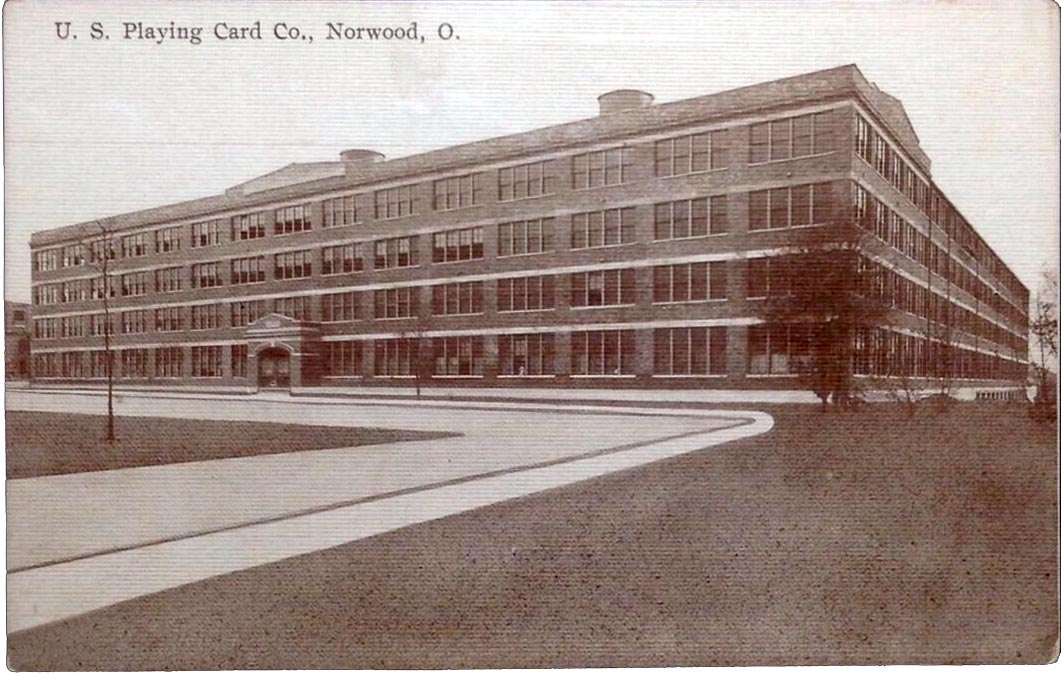

By Simon Wintle
Member since February 01, 1996
I am the founder of The World of Playing Cards (est. 1996), a website dedicated to the history, artistry and cultural significance of playing cards and tarot. Over the years I have researched various areas of the subject, acquired and traded collections and contributed as a committee member of the IPCS and graphics editor of The Playing-Card journal. Having lived in Chile, England, Wales, and now Spain, these experiences have shaped my work and passion for playing cards. Amongst my achievements is producing a limited-edition replica of a 17th-century English pack using woodblocks and stencils—a labour of love. Today, the World of Playing Cards is a global collaborative project, with my son Adam serving as the technical driving force behind its development. His innovative efforts have helped shape the site into the thriving hub it is today. You are warmly invited to become a contributor and share your enthusiasm.
Related Articles

Rap Rummy
Rap Rummy made by Parker Brothers in 1926, only 4 years after the discovery of King Tutankhamen’s to...

German Travel Cards
A travel-themed educational deck helping American tourists visiting Germany.

Can You Believe Your Eyes?
“Can You Believe Your Eyes?” playing cards featuring visual illusions & other oddities.

Get Decked
Black and white cartoons devised by Sam Wagner with help from artist Lindsay Bevington.

Beowulf
Jackson Robinson's Beowulf playing card deck inspired by the Old English pagan poem.

Keith Haring playing cards
Energetic graffiti images by the American artist Keith Haring.

The Tarot of Meditation – Yeager Tarot
Marty Yeager’s original Tarot of Meditation from 1975, republished later by U.S. Games Systems, Inc....

Adobe Deck
The first digitally-produced deck of cards.

Seminole Wars deck
Seminole Wars deck by J. Y. Humphreys, Philadelphia, c.1819.

The UCR Deck
Giant-size cards designed by Thomas Sanders to advertise courses and facilities at UCR.

Fredericks & Mae playing cards
A rainbow pack from the design team of Fredericks & Mae and Benjamin English.

Red Hat Society playing cards
Society that encourages women in their quest to get the most out of life.

Mountain Dream Tarot
Groundbreaking Tarot created by Bea Nettles, using photographs and photo montage.

Junior Playing Cards
Child-friendly versions of standard English pattern cards designed by Louie Mantia, Jr.

Last Call Cats playing cards
Bar-crawling cats, designed by artists Arna Miller and Ravi Zupa.

Covered bridges playing cards
Historical covered bridges with photography by Bill Miller, 2006.
Most Popular
Our top articles from the past 28 days


